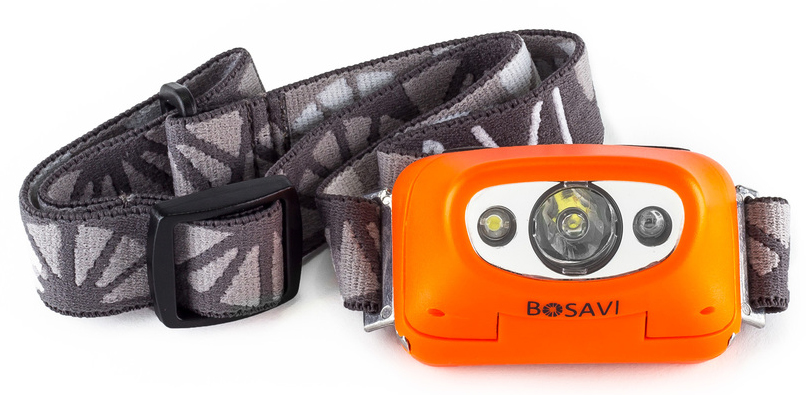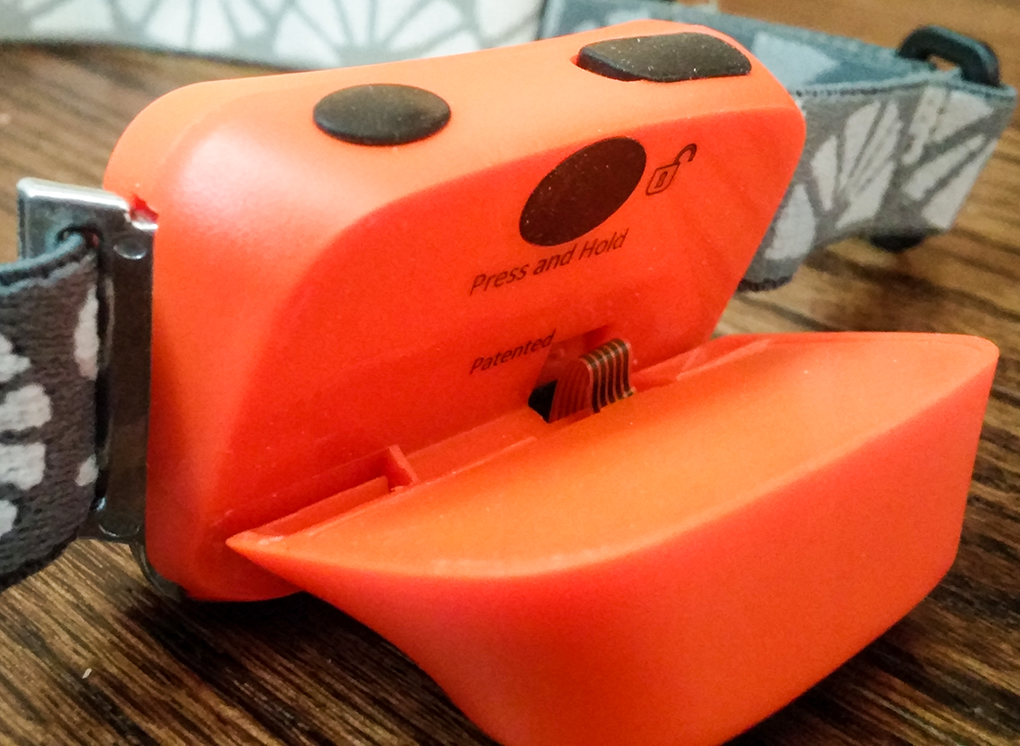
Bosavi Rechargeable LED Headlamp
Stated Weight: 2.21oz
Features:
- Rechargeable by USB
- Red light night vision mode
- Lock button
- Programmable modes
- 110 Lumen “Boost Mode”
- 3.7V/700mAH Li-Poly battery
Stated Run Times:
- High Power Mode: 6 hours
- Optimum Mode: 12 Hours
- Economy Mode: 65 hours
MSRP: $69.95
Headlamps, in the modern age at least, embody an exceedingly simple idea: take a small, cheap, and readily accessible LED, marry it to an equally-accessible power supply, and mount the pair on your head or helmet with an elastic band. In this sense, the headlamp is about as basic as outdoor equipment gets.
Yet like the “better mousetrap” from the oft-misremembered Emerson quote [Editor’s Note: NERD!], the headlamp is constantly reinvented, ostensibly improved upon, and revisited year-in and year-out independent of whether LED’s or batteries have actually improved in the interim.
Sometimes these improvements represent real steps forward in terms of features or functionality. Very often, however, unnecessary features are added, resulting in a product that has either been over-engineered, or simply imperfectly suited to a given user.
How, then, does a company like Bosavi look around and decide that there is work yet undone in the headlamp market?
Part of the answer involves identifying the end user. The multitude of possible applications for headlamps makes room for many different styles, each with an emphasis on different attributes. For example, a headlamp optimized for caving will make very different compromises than one designed for trail running.
Bosavi offers a single headlamp plus the obligatory accoutrements, and while their headlamp can certainly be used in most situations, climbers and trailrunners are likely to be the most interested in this particular headlamp.
It’s worth mentioning that Bosavi is a small company born out of a successful Kickstarter campaign, with one headlamp and no other gear in their catalog, which distinguishes them somewhat from larger companies such as Black Diamond or Petzl.
Back to the headlamps. I generally prefer lightweight functionality and simplicity to other metrics: for the most part, modern headlamps all have sufficient battery life to get me through whatever my objective is, and I’m much more likely to be annoyed by excess bulk or weight than by running out of juice after dozens of hours of continuous use.
Power / Brightness
This headlamp is not the brightest on the market, though it’s pretty impressive for its size and weight. The max output (in “boost mode” – more on that shortly) is 110 lumens compared to Petzl’s Tikka XP which offers 160 lumens. However, lumens don’t tell the whole story.
The quality of light output for a headlamp is a little more nuanced than just its max lumens. For a more detailed breakdown of the physics involved, see the addendum below, otherwise proceed with the knowledge that, in very broad strokes, more lumens generally means brighter light.
Both those numbers reflect the performance in “boost mode,” where you can marshal high levels of output for very short bursts—as in, ‘a couple minutes’ short.
The Tikka has a 2 minute lifetime at that output range, while the Bosavi (because it boosts to a lower intensity) lasts for four minutes before automatically reverting back to the regular setting. This is a nice feature because it’s easy to forget you’re in boost mode, so you then drain your battery about as quickly as you can cook ramen.
Features
Speaking of modes, this is where things get a little murky with many headlamps. How many modes do I need? Do I need a blinking red light for emergencies? Do I need a blinking white light for bike rides? Is that even a thing?
When I got started with the Bosavi headlamp, this was my central gripe: too many modes! I hate cycling through them when I really only use two or, at most, three. And seven is just overkill!
Upon closer inspection, this was only a problem because of my bad habit of throwing away instruction manuals. You would think I’d have learned my lesson by now, but I seem do this indiscriminately with everything from headlamps, to cameras and cell phones, to complex pieces of research-grade lab equipment. My hubris knows no bounds.
In this case, the lesson lost was that the Bosavi is programmable so that the user can “hide” certain modes so that you don’t have to cycle through them. This is brilliant.
Ultimately headlamps are at their best when I’m not thinking about them. Flicking through seven settings is irritating because I inevitably flick past the one I wanted. Reducing this to three with the knowledge that I can still access the others is a great compromise.
Additional Features, Rechargeability, Weight
As far as other bells and whistles go, there is a very nice and well-hidden “hold” button, so you don’t waste your batteries by inadvertently turning on the lamp in your pack. This a great feature, but one now widely available on many headlamps. It is also somewhat resistant to water in the form of rain, but definitely isn’t waterproof enough to be submerged.

The other thing you need to know about the Bosavi is that it is entirely rechargeable—no removable batteries, no AA’s, no AAA’s. Just a micro USB port that charges from the wall / computer / car / whatever.
This will likely be industry standard before long, and is already available in some other top of the line headlamps like the Tikka RXP (which also comes with a $100 price tag), but is a fantastic move nonetheless.
Having only microUSB-rechargeable batteries means you can’t bring extra power along for long trips, but it allows Bosavi to fit their headlamp into a very small, very light package — 2.2 oz (!) vs. 4 oz for the Tikka RXP.
Bosavi Rechargeable LED Headlamp vs. the Black Diamond ReVolt
Black Diamond also makes a “rechargeable” headlamp, the ReVolt, that is actually cheaper ($59.95) than the Bosavi, and that can operate on AAA batteries. While we haven’t tested the ReVolt, the ability to easily recharge it via USB or supplement it with batteries in a pinch makes it very attractive. So does the ReVolt trump the Bosavi on all fronts? Not quite.
The case to be made for the Bosavi over the ReVolt is:
1.) It’s significantly lighter. Granted, the ReVolt at 96-100g isn’t exactly brick heavy, but it’s still more than 50% heavier than the Bosavi.
2.) The rechargeable batteries in the ReVolt are rechargeable AAA batteries (which these days are typically NiMH – or Nickel-Metal hydride- batteries), while the Bosavi uses a lithium ion cell more akin to what’s in your cell phone. Without going too battery crazy here, lithium ion batteries like those in the Bosavi are more stable and provide a higher specific energy (lighter weight for the same charge capacity) than either NiMh or traditional lead-acid batteries, though they’re more expensive.
The crux of the difference is this: the ReVolt uses AAA batteries just like a traditional headlamp, but you’ve got the option to use rechargeable AAA’s instead of regular AAA’s and can recharge them while in the headlamp casing rather than removing them.
Because NiMh batteries are supposed to have a low internal resistance, people often claim that they get lower discharge rates from them compared to normal batteries, so using rechargeable AAA’s in the ReVolt might give you a less bright light than using regular AAA’s.
So technically, yes, the ReVolt is a rechargeable headlamp, but it really still resides in the AAA battery domain and sort of sneaks into the rechargeable market on a technicality, in my opinion.
On the other hand, the Bosavi uses a lithium ion cell battery that’s more modern, lighter, and will give you much greater cycling stability and capacity retention over the course of the battery’s lifetime. Of course, you can’t replace those nearly as easily as you can a AAA, but, hey, you can’t have it all.
Bottom Line
The Bosavi headlamp makes an interesting, and ultimately compelling case for itself. Is it the brightest? No. Most Features? Nope. Waterproof? Not Entirely.
But for fast-and-light use that still delivers a high degree of functionality, I can’t really think of anything else that touches it—especially for $70. The programmable feature is awesome, and the overall package is extremely trim and streamlined.
For niche applications like caving, or anything requiring super bright light or the ability to use regular batteries, you are best off with a different headlamp.
But for climbers, runners, and bikers, the Bosavi is a real win.
* Technical Addendum
Measuring headlamps by lumens is only moderately informative at best. It’s similar to judging ropes based on the number of falls they sustained in a UIAA test: it’s interesting and relevant information, but not complete enough to use as a stand-alone metric. (But that’s an article for another day.)
For the technically inclined, lumens are an SI-derived unit (meaning it is derived from some combination of the seven primary SI units) which measure luminous flux: the total “quantity” of light emitted into a specified angle.
The unit angle in this case is the steradian: the steradian is to spheres as the radian is to circles. Consequently, lumens indicate the optical density as a product of the number of candelas (a vector-based measure of light intensity, also the base SI unit) and a specified beam angle.
Bringing this back to headlamps, the lumens take into account not only the brightness of the light (candelas would be the actual metric for this) but also the shape and size of the beam. It is then easy to see, given headlamps with very different beam shapes, how one could end up with different degrees of brightness despite having the same number of lumens.
When you’re looking to buy a headlamp, see if you can discern the beam shape, then decide whether or not you’re interested in diffuse light, a focused beam, or the ability to switch between the two, and make a mental note when comparing lumens.
